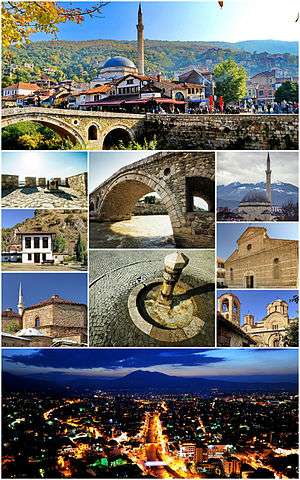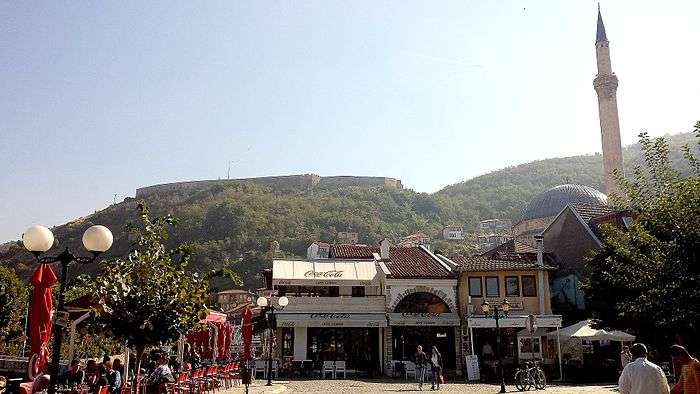Prizren
| Prizren Prizren or Prizreni (Albanian) Призрен or Prizren (Serbian) | |
|---|---|
| City and municipality | |
|
Clockwise from top: old town, the fortress, stone bridge, Sinan Pasha Mosque, Prizren League Building, Shadervan Square, Cathedral of Our Lady of Perpetual Succour, Gazi Mehmet Pasha Hammam, Our Lady of Ljeviš and Prizren during the evening. | |
 Prizren Location in Kosovo | |
| Coordinates: 42°13′N 20°44′E / 42.217°N 20.733°ECoordinates: 42°13′N 20°44′E / 42.217°N 20.733°E | |
| Country |
Kosovo (De Jure) Serbia (De Facto) |
| District | District of Prizren |
| Government | |
| • Mayor | Ramadan Muja |
| Area | |
| • City and municipality | 640 km2 (250 sq mi) |
| • Urban | 22.390 km2 (8.645 sq mi) |
| Elevation | 450 m (1,480 ft) |
| Population (2014) | |
| • City and municipality | 184,586 |
| • Density | 290/km2 (750/sq mi) |
| Time zone | CET (UTC+1) |
| • Summer (DST) | CEST (UTC+2) |
| Postal code | 20000-20080 |
| Area code(s) | (+383) 29 |
| Car plates | 04 |
| Climate | Cfb |
| Website |
kk |
Prizren (Albanian: Prizreni, Serbian: Призрен; pronounced [prîzrɛn]) is a historic city in Kosovo. It is the administrative center of Prizren municipality and district. The city has a population of around 178,000 (2011 census preliminary results),[1] making it the second largest city in Kosovo.
The residents of Prizren are mostly ethnic Albanians. Prizren is located on the banks of the Prizren Bistrica river, and on the slopes of the Šar Mountains (Albanian: Malet e Sharrit) in the southern part of the Republic of Kosovo. The municipality has a border with Albania and the Republic of Macedonia.[2]
By road the city is 99 kilometres (62 miles) northwest of Skopje, 85 kilometres (53 miles) south of Pristina and 175 kilometres (109 miles) northeast of Tirana.
History
Ancient
The Roman[3] town of Theranda in Ptolemy's Geography is mentioned in the 2nd century AD. In the 5th century, it is mentioned as being restored in Dardania with the name of Petrizên by Procopius of Caesarea in De aedificiis (Book IV, Chapter 4).[4] Sometimes it is mentioned even in relation to the Justiniana Prima. It is thought that its modern name comes from old Serbian Призрѣнь (Prizren), from при-зрѣти (pri-zreti), indicating fortress which could be seen from afar[5] (compare with Czech Přízřenice or mount Ozren), and it may also derive from Petrizen mentioned by Procopius.[6]
Medieval
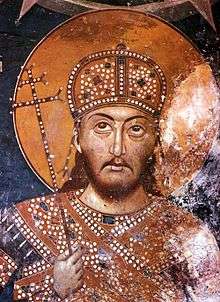
Konstantin Jireček concluded, from the correspondence of bishop Demetrios Chomatenos of Ohrid (1216–36), that Prizren was the northeasternmost area of Albanian settlement prior to the Slavic expansion.[7]
Bulgarian rulers controlled the Prizren area from the 850s, and Slav migrants arriving in the area were subsequently influenced by the Bulgarian-organized Archbishopric of Ohrid (est. 1018). Bulgarian rule was replaced by Byzantine rule in the early eleventh century.[8]
In 1072, the Bulgarian and Serb nobility of Macedonia rose up against the Byzantines, and crowned Serbian ruler Constantine Bodin, a descendant of the Serbian Vojislavljević dynasty, as Emperor of Bulgaria in Prizren. The revolt was suppressed by 1073.[9] The area was raided by Serbian ruler Vukan in the 1090s.[10]
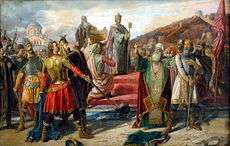
In 1180 to 1190, the Serbian Grand Prince Stefan Nemanja conquered the district of Prizren[11] this may refer to the Prizren diocese rather than the city itself, and he later lost control of these areas.[12] Stefan Nemanja regained control of Prizren some time between 1208 and 1216. In 1220, the Byzantine Greek Orthodox bishop of the city was expelled as the Serbian rulers imposed their own ecclesiastical jurisdiction.[13] Stefan Dušan used Prizren as capital of Serbian Empire.[14][15] In the next centuries before the Ottoman conquest the city would pass to the Mrnjavčević and Balsić families.
The Catholic church retained some influence in the area; 14th-century documents refer to a catholic church in Prizren, which was the seat of a bishopric between the 1330s and 1380s. Catholic parishes served Ragusan merchants and Saxon miners.[16]
Ottoman Period

After several years of attack and counterattack, the Ottomans made a major invasion of Kosovo in 1454; Đurađ Branković retreated to the north and asked for help from John Hunyadi. On 21 June 1455, Prizren surrendered to the Ottoman army.[17] Prizren was the capital of the Sanjak of Prizren, and under new administrative organization of Ottoman Empire it became capital of the Vilayet.[18] This included the city of Tetovo.[19] Later it became a part of the Ottoman province of Rumelia. It was a prosperous trade city, benefiting from its position on the north-south and east-west trade routes across the Empire. Prizren became one of the larger cities of the Ottomans' Kosovo Province (vilayet). Prizren was the cultural and intellectual centre of Ottoman Kosovo. It was dominated by its Muslim population, who composed over 70% of its population in 1857. The city became the biggest Albanian cultural centre and the coordination political and cultural capital of the Kosovar Albanians. In 1871, a long Serbian seminary was opened in Prizren, discussing the possible joining of the old Serbia's territories with the Principality of Serbia.
It was an important part of Kosovo Vilayet between 1877 and 1912.


During the late 19th century the city became a focal point for Albanian nationalism and saw the creation in 1878 of the League of Prizren, a movement formed to seek the national unification and liberation of Albanians within the Ottoman Empire. The Young Turk Revolution was a step in the dissolving of the Ottoman empire that led to the Balkan Wars. The Third Army (Ottoman Empire) had a division in Prizren, the 30th Reserve Infantry Division (Otuzuncu Pirzerin Redif Fırkası).
Modern
The Prizren attachment was part of the İpek Detachment in the Order of Battle, October 19, 1912 in the First Balkan War. During the First Balkan War the city was seized by the Serbian army and incorporated into the Kingdom of Serbia. Although the troops met little resistance, the takeover was bloody with 400 people dead in the first few days; the local population would call the city 'The Kingdom of Death'.[20] The Daily Chronicle reported on 12 November 1912 that 5,000 Albanians had been slaughtered in Prizren.[20] General Božidar Janković forced the local Albanian leaders to sign a declaration of gratitude to King Peter of Serbia for their 'liberation by the Serbian army.'[20][21] Following the capture of Prizen, most foreigners were barred from entering the city, for the Montenegrin forces temporarily closed the city before full control was restored. A few visitors did make it through—including Leon Trotsky, then working as a journalist for a Ukrainian newspaper and reports eventually emerged of widespread killings of Albanians.[22] In a 1912 news report on the Serbian Army and the Paramilitary Chetniks in Prizren, Trotsky stated "Among them were intellectuals, men of ideas, nationalist zealots, but these were isolated individuals. The rest were just thugs, robbers who had joined the army for the sake of loot... The Serbs in Old Serbia, in their national endeavour to correct data in the ethnographical statistics that are not quite favourable to them, are engaged quite simply in systematic extermination of the Muslim population".[23] British traveller Edith Durham and a British military attaché were supposed to visit Prizren in October 1912, however the trip was prevented by the authorities. Durham stated " I asked wounded Montengrins [Soldiers] why I was not allowed to go and they laughed and said 'We have not left a nose on an Albanian up there!' Not a pretty sight for a British officer." Eventually Durham visited a northern Albanian outpost in Kosovo where she met captured Ottoman soldiers whose upper lips and noses had been cut off.[23]
After the First Balkan War of 1912, the Conference of Ambassadors in London allowed the creation of the state of Albania and handed Kosovo to the Kingdom of Serbia, even though the population of Kosovo remained mostly Albanian.[24]
In 1913, an official Austro-Hungarian report recorded that 30,000 people had fled Prizren for Bosnia.[25] In January 1914 the Austro-Hungarian consul based in Prizren conducted a detailed report on living conditions in the city. The report stated that Kingdom of Serbia didn't keep its promise for equal treatment of Albanians and Muslims. Thirty of the thirty-two Mosques in Prizren had been tuned into hay barns, ammunition stores and military barracks. The people of the city were heavily taxed with Muslims and Catholic Christians having to pay more tax than Orthodox Christians. The local government was predominately made up of former Serb Chetniks and corruption thrived. The report also noted that the Serbs were also dissatisfied with the living conditions in Prizren.[25]
World War I and World War II

With the outbreak of the First World War, the Kingdom of Serbia was invaded by Austro-Hungarian forces and later by Bulgarian forces. By 29 November 1915, Prizren fell to Bulgarian and Austro-Hungarian forces.[26] In April 1916, Austria-Hungary allowed the Kingdom of Bulgaria to occupy the city with the understanding that a significant amount of the city's population were ethnic Bulgarians.[27] During this period there was a process of forced Bulgarisation with many Serbs being interned; Serbs suffered worse in Bulgarian occupied regions of Kosovo compared to Austrian occupied regions due to the Bulgarian defeat in the Second Balkan War and due to the long-standing rivalry between the Bulgarian Orthodox Church and the Serbian Orthodox Church.[28] According to Catholic Archbishop of Skopje, Lazër Mjeda who was taking refuge in Prizren at the time, roughly 1,000 people had died of hunger in 1917. In October 1918 following the fall of Macedonia to Allied Forces, the Serbian Army along with the French 11th colonial division and the Italian 35th Division pushed the Austro-Hungarian and Bulgarian forces out of the city.[28] By the end of 1918, the Kingdom of Serbs, Croats and Slovenes was formed. The Kingdom was renamed in 1929 to the Kingdom of Yugoslavia and Prizren became a part of its Vardar Banovina.
In World War II Nazi Germany and Fascist Italy invaded the Kingdom of Yugoslavia on 6 April 1941 and by 9 April the Germans who had invaded Yugoslavia from the East with neighbouring Bulgaria as base were on the outskirts of Prizren and by 14 April Prizren had fallen to the Italians who had invaded Yugoslavia from the West in neighbouring Albania; there was however notable resistance in Prizen before Yugoslavia unconditionally surrendered on 19 April 1941.[29] Prizren along with most of Kosovo was annexed to the Italian puppet state of Albania. Soon after the Italian occupation, the Albanian Fascist Party established a blackshirt battalion in Prizren, but plans to establish two more battalions were dropped due to the lack of public support.[30]
In 1943 Bedri Pejani of the German Wehrmacht helped create the Second League of Prizren.[31]
Federal Yugoslavia
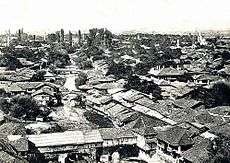
In 1944, German forces were driven out of Kosovo by a combined Russian-Bulgarian force, and then the Communist government of Yugoslavia took control.[33] In 1946, the town was formulated as a part of Kosovo and Metohija which the Constitution defined the Autonomous Region of Kosovo and Metohija within the People's Republic of Serbia, a constituent state of the Federal People's Republic of Yugoslavia.
The Province was renamed to Socialist Autonomous Province of Kosovo in 1974, remaining part of the Socialist Republic of Serbia, but having attributions similar to a Socialist Republic within the Socialist Federal Republic of Yugoslavia. The former status was restored in 1989, and officially in 1990.
For many years after the restoration of Serbian rule, Prizren and the region of Dečani to the west remained centres of Albanian nationalism. In 1956 the Yugoslav secret police put on trial in Prizren nine Kosovo Albanians accused of having been infiltrated into the country by the (hostile) Communist Albanian regime of Enver Hoxha. The "Prizren trial" became something of a cause célèbre after it emerged that a number of leading Yugoslav Communists had allegedly had contacts with the accused. The nine accused were all convicted and sentenced to long prison sentences, but were released and declared innocent in 1968 with Kosovo's assembly declaring that the trial had been "staged and mendacious."
Kosovo War

The town of Prizren did not suffer much during the Kosovo War but its surrounding municipality was badly affected 1998–1999. Before the war, the Organization for Security and Co-operation in Europe estimated that the municipality's population was about 78% Kosovo Albanian, 5% Serb and 17% from other national communities. During the war most of the Albanian population were either forced or intimidated into leaving the town. Tusus Neighborhood suffered the most. Some twenty-seven to thirty-four people were killed and over one hundred houses were burned.[34]
At the end of the war in June 1999, most of the Albanian population returned to Prizren. Serbian and Roma minorities fled, with the OSCE estimating that 97% of Serbs and 60% of Romani had left Prizren by October. The community is now predominantly ethnically Albanian, but other minorities such as Turkish, Ashkali (a minority declaring itself as Albanian Roma) and Bosniak (including Torbesh community) live there as well, be that in the city itself, or in villages around. Such locations include Sredska, Mamuša, the region of Gora, etc.
The war and its aftermath caused only a moderate amount of damage to the city compared to other cities in Kosovo.[35] Serbian forces destroyed an important Albanian cultural monument in Prizren, the League of Prizren building,[36][37] but the complex was rebuilt later on and now constitutes the Albanian League of Prizren Museum.
On March 17, 2004, during the Unrest in Kosovo some Serb cultural monuments in Prizren were damaged, burned or destroyed, such as old Orthodox Serb churches:
- Our Lady of Ljeviš from 1307 (UNESCO World Heritage Site)[38]
- the Church of Holy Salvation[38]
- Church of St. George[38] (the city's largest church)
- Church of St. George[38] (Runjevac)
- Church of St. Kyriaki, Church of St. Nicolas (Tutić Church)[38]
- the Monastery of The Holy Archangels,[38] as well as
- Prizren's Orthodox seminary of Saint Cyrillus and Methodius[38]
Also, during that riot, entire Serb quarter of Prizren, near the Prizren Fortress, was completely destroyed, and all remaining Serb population was evicted from Prizren.[39][40] Simultaneously Islamic cultural heritage and Mosques were being destroyed and damaged in Belgrade and Niš.[41]
21st century
The municipality of Prizren is still the most culturally and ethnically heterogeneous of Kosovo, retaining communities of Bosniaks, Turks, and Romani in addition to the majority Kosovo Albanian population live in Prizren. Only a small number of Kosovo Serbs remains in Prizren and area, residing in small villages, enclaves, or protected housing complexes. Furthermore, Prizren's Turkish community is socially prominent and influential, and the Turkish language is widely spoken even by non-ethnic Turks.
Geography
Climate
| Climate data for Prizren (1961–1990) | |||||||||||||
|---|---|---|---|---|---|---|---|---|---|---|---|---|---|
| Month | Jan | Feb | Mar | Apr | May | Jun | Jul | Aug | Sep | Oct | Nov | Dec | Year |
| Record high °C (°F) | 20.2 (68.4) |
22.4 (72.3) |
26.0 (78.8) |
31.3 (88.3) |
33.8 (92.8) |
40.6 (105.1) |
40.8 (105.4) |
37.3 (99.1) |
35.8 (96.4) |
31.4 (88.5) |
25.6 (78.1) |
23.7 (74.7) |
40.8 (105.4) |
| Average high °C (°F) | 3.3 (37.9) |
6.8 (44.2) |
11.9 (53.4) |
17.2 (63) |
22.5 (72.5) |
26.0 (78.8) |
28.5 (83.3) |
28.3 (82.9) |
24.5 (76.1) |
18.0 (64.4) |
11.1 (52) |
5.0 (41) |
16.9 (62.4) |
| Daily mean °C (°F) | 0.0 (32) |
2.8 (37) |
7.1 (44.8) |
11.9 (53.4) |
16.8 (62.2) |
20.2 (68.4) |
22.2 (72) |
21.8 (71.2) |
18.1 (64.6) |
12.3 (54.1) |
6.9 (44.4) |
1.8 (35.2) |
11.8 (53.2) |
| Average low °C (°F) | −3.0 (26.6) |
−0.6 (30.9) |
2.7 (36.9) |
6.9 (44.4) |
11.3 (52.3) |
14.4 (57.9) |
15.8 (60.4) |
15.4 (59.7) |
12.1 (53.8) |
7.3 (45.1) |
3.2 (37.8) |
−1.0 (30.2) |
7.1 (44.8) |
| Record low °C (°F) | −23.6 (−10.5) |
−19.1 (−2.4) |
−11.7 (10.9) |
−2.6 (27.3) |
−0.4 (31.3) |
3.8 (38.8) |
7.3 (45.1) |
7.0 (44.6) |
−0.8 (30.6) |
−4.3 (24.3) |
−12.6 (9.3) |
−17.4 (0.7) |
−23.6 (−10.5) |
| Average precipitation mm (inches) | 76.2 (3) |
54.1 (2.13) |
63.5 (2.5) |
61.1 (2.406) |
66.7 (2.626) |
69.7 (2.744) |
58.6 (2.307) |
127.4 (5.016) |
58.2 (2.291) |
55.1 (2.169) |
88.3 (3.476) |
81.1 (3.193) |
860.0 (33.858) |
| Average precipitation days (≥ 0.1 mm) | 12.8 | 12.1 | 12.1 | 12.8 | 12.3 | 11.6 | 8.9 | 7.5 | 8.1 | 9.3 | 12.6 | 13.5 | 133.6 |
| Average snowy days | 7.6 | 5.6 | 3.8 | 0.4 | 0.0 | 0.0 | 0.0 | 0.0 | 0.0 | 0.1 | 2.1 | 5.8 | 25.4 |
| Average relative humidity (%) | 81 | 75 | 68 | 64 | 64 | 61 | 58 | 59 | 67 | 74 | 79 | 82 | 69 |
| Mean monthly sunshine hours | 100.2 | 92.0 | 139.4 | 176.2 | 224.5 | 290.7 | 300.8 | 285.7 | 220.7 | 163.4 | 89.7 | 54.1 | 2,137.4 |
| Source: Republic Hydrometeorological Service of Serbia[42] | |||||||||||||
Demographics
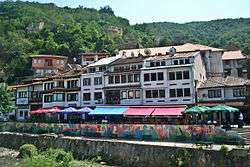
As in other cities of the Balkans that underwent Ottoman urban development, the population largely converted to Islam in the 16th century, although part of the former Catholic converts professed a form of crypto-Christianity (laramanë). An aspect of this new urban character is evidenced by the demographics of workshop owners; 227 of 246 workshops of Prizren were run by Muslims in 1571.[43] As the Catholic population dwindled, prelatic missions and reports in the region increased. Marino Bizzi, Archbishop of Antivari, in his 1610 report stated that Prizren had 8.600 large houses.[44] The Christian part of the city was formed by Catholics (30 households), whose churches had been reduced to two (from a total of 80), and Orthodox, who outnumbered them and spoke the Dalmatian language.[44] In 1623, Pjetër Mazreku, who in 1624 succeeded Bizzi as Archbishop of Antivari, reported that the city was populated mostly by Muslims, who numbered 12,000 and were mostly Albanians.[45] The Catholics of the city spoke Albanian and Slavic and 200 of them were Albanians.[45][46] The Orthodox element was composed of 600 Serbs.[45] In 1857, Russian Slavist Alexander Hilferding's publications place the Muslim families at 3,000, the Orthodox ones at 900 and the Catholics at around 100 families.[47] The Ottoman census of 1876, placed the total population at around 44,000.
| Demographics | |||||||||||||
| Year | Albanians | % | Bosniaks | % | Serbs | % | Turks | % | Roma | % | Others | % | Total |
|---|---|---|---|---|---|---|---|---|---|---|---|---|---|
| 1991 census | 132,591 | 75.58 | 19,423 | 11.1 | 10,950 | 6.24 | 7,227 | 4.1 | 3,96 3 | 2.3 | 1,259 | 0.7 | 175,413 |
| January 2000 | 181,531 | 76.9 | 37,500 | 15.9 | 258 | 0.1 | 12,250 | 5.2 | 4,500 | 1.9 | n/a | n/a | 236,000 |
| December 2002 | 180,176 | 81.6 | 21,266 | 9.6 | 221 | 0.09 | 14,050 | 6.4 | 5,148 | 2.3 | n/a | n/a | 221,374 |
| 2011 | 145,718 | 81.97 | 16,896 | 9.5 | 237 | 0.13 | 9,091 | 5.1 | 2,899 | 1.63 | 2940 | 1.65 | 177,781 |
| Source: For 1991: Census data, Federal Office of Statistics in Serbia (figures to be considered as unreliable). 1998 and 2000 minority figures from UNHCR in Prizren, January 2000. 2000 Kosovo Albanian figure is an unofficial OSCE estimate January–March 2000. 2001 figures come from German KFOR, UNHCR and IOM last update March 2, 2001. May 2002 statistics are joint UN, UNHCR, KFOR, and OSCE approximations. December 2002 figures are based on survey by the Local Community Office. All figures are estimates. Ref: OSCE .pdf | |||||||||||||
Languages
In Prizren Municipality, the Albanian, Serbian, Bosnian and Turkish languages are official languages.[48][49]
Education
There are 48 primary schools with 28,205 pupils and 1,599 teachers; six (6) secondary schools with 9,608 students and 503 teachers; kindergartens are privately run. There is also a public university in Prizren, offering lectures in Bosnian, Albanian and Turkish languages (source: municipal directorate of education and science).
Health
The primary health care system includes 14 municipal family health centres and 26 health houses. The primary health sector has 475 employees, including doctors, nurses and support staff, 264 female and 211 male. Regional hospital in Prizren offers services to approximately 250,000 residents. The hospital employs 778 workers, including 155 doctors, and is equipped with emergency and intensive care units.
Economy
For a long time the economy of Kosovo was based on retail industry fueled by remittance income coming from a large number of immigrant communities in Western Europe. Private enterprise, mostly small business, is slowly emerging food processing. Private businesses, like elsewhere in Kosovo, predominantly face difficulties because of lack of structural capacity to grow. Education is poor, financial institutions basic, regulatory institutions lack experience. Central and local legislatures do not have an understanding of their role in creating legal environment good for economic growth and instead compete in patriotic rhetoric. Securing capital investment from foreign entities cannot emerge in such an environment. Due to financial hardships, several companies and factories have closed and others are reducing personnel. This general economic downturn contributes directly to the growing rate of unemployment and poverty, making the financial/economic viability in the region more tenuous.[50]
Many restaurants, private retail stores, and service-related businesses operate out of small shops. Larger grocery and department stores have recently opened. In town, there are eight sizeable markets, including three produce markets, one car market, one cattle market, and three personal/hygienic and house wares markets. There is an abundance of kiosks selling small goods. Prizren appears to be teeming with economic prosperity, but appearances are deceiving as the international presence is reduced and repatriation of refugees and internally displaced persons is expected to further strain the local economy. Market saturation, high unemployment, and a reduction of financial remittances from abroad are ominous economic indicators.[50]
There are three agricultural co-operatives in three villages. Most livestock breeding and agricultural production is private, informal, and small-scale. There are five operational banks with branches in Prizren, the Micro Enterprise Bank (MEB), the Raiffeisen Bank, the Nlb Bank, the Teb Bank and the Payment and Banking Authority of Kosovo (BPK).[50]
Infrastructure
All the main roads connecting the major villages with the urban centre are asphalted. The water supply is functional in Prizren town and in approximately 30 villages. There is no sewage system in the villages. Power supply is still a problem, especially during the winter and in the villages.
Culture
Prizren is home to the annually held documentary film festival Dokufest.
The city is also home to numerous mosques, Orthodox and Catholic churches and other monuments. Among them:
- Sinan Pasha Mosque
- The Mosque of Muderis Ali Efendi
- Mosque Katip Sinan Qelebi
- Saint Archangels Monastery
- League of Prizren Monument
- Kaljaja fortress
- Church of Holy Salvation
- Our Lady of Ljeviš church
- Church of St. Nicholas
- Church of St. Kyriaki
- The St. George Cathedral
- Cathedral of Our Lady of Perpetual Succour
- The Lorenc Antoni Music school
- Theater
- Shuaip Pasha's House
- Orthodox Seminary of Prizren
Sports
The city has one sports club known as KF Liria based in Prizren near Kosovo. They currently play in the Football Superleague of Kosovo.
Monuments
These monuments, part of the historic center of the city, have recently been threatened by development pressures.[51] In addition, war, fires, general dilapidation and neglect have taken their toll on this unique architectural landscape.[52]
| Name | Description | Picture |
|---|---|---|
| The Shadervan Turkish: Şadırvan is a tourist area on the south side of town, there are numerous cafes and restaurants there. The ancient water fountain is a protected cultural monument, there is a legend that if you drink from it you will be sure to come back.[53][54][55] |  | |
| The Old Stone Bridge (Albanian: Ura e gurit, Serbian: Стари камени мост), Bosnian: Stari kameni most) is one of the landmarks of Prizren. It crosses the Prizrenska Bistrica. | 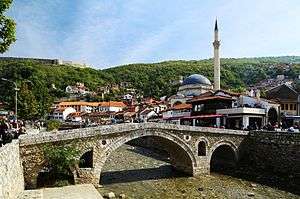 | |
| The Tannery/Leatherworks in Prizren (Albanian: Lagjia e Tabakëve, Bosnian: Prizrenska Tabahana[56] )[57] is an ancient handcraft building. Tabakëve is the Albanian, and табахана the Serbian version, both from Turkish: 'tr:Tabakhane', where -ana means house.[58] | ||
| UNESCO-protected 14th century Serbian orthodox monastery Our Lady of Ljevis |  | |
| 1534 (1543?) Mosque of Kuklibeu (Albanian: Xhamia e Kuklibeut, originating from Turkish: Kutlu Bey Camii) also known as Kukli Bej Mosque | | |
| Mosque of Mustafe Pashe Prizrenit (Turkish: Prizrenli Mustafa Paşa Camii, Albanian: Xhamia e Mustafë Pashë Prizrenit/Xhamia e Mustafa Pashës). 1562–1563 Destroyed in 1950 after a storm. It was located at the location of the former UNMIK headquarters, now municipality building 42°12′36″N 20°44′11″E / 42.210060°N 20.736372°E | ||
| 1543–1581 Mosque of Muderis Ali Efendi (Turkish: Müderris Ali Efendi Camii) | | |
| The Sinan Pasha Mosque (Albanian: Xhamia e Sinan Pashës, Bosnian: Sinan-pašina džamija, Turkish: Sinan Paşa Camii) is an Ottoman mosque in the city of Prizren, Kosovo. It was built in 1615 by Sofi Sinan Pasha, bey of Budim.[59] The mosque overlooks the main street of Prizren and is a dominant feature in the town's skyline.[60] | ||
Minaret of Arasta Mosque | The remaining minaret of the Arasta Mosque | |
Events and festivals
NGOM Fest
NGOM Fest is a music festival established in Prizren. The word "Ngom" means "Listen to me" in the Gheg Albanian dialect. The first edition of the festival was held on June 2011 and due to its success, further events were organised. The main objectives of the festival are to promote new bands and artists, build a new perspective for music festivals in Kosovo, and to connect different ethnic groups in Kosovo and in the region.[61][62]
40BunarFest
40BunarFest is an annual non traditional festival of alternative sport held in Prizren.
International relations
Prizren is twinned with:
See also
References
- ↑ "Preliminary Results of the Kosovo 2011 population and housing census". The statistical Office of Kosovo. Retrieved 17 April 2012.
- ↑ Vickers, Miranda (1999). The Albanians: A Modern History. I.B.Tauris. p. 97. ISBN 978-1-86064-541-9.
- ↑ THERANDA (Prizren) Yugoslavia, The Princeton Encyclopedia of Classical Sites, A Roman town about 76 km (47.22 mi) SW of Priština on the Bistrica river. It lay on the direct route from Lissos in Macedonia to Naissus in Moesia Superior. The town continued to exist during the 4th to 6th century, but was of far greater significance during the mediaeval period and was even capital of Serbia for a short time during the 14th century.
- ↑ http://penelope.uchicago.edu/Thayer/E/Roman/Texts/Procopius/Buildings/4B*.html
- ↑ Detelić, Mirjana: Градови у хришћанској и муслиманској епици, Belgrade, 2004, ISBN 86-7179-039-8.
- ↑ Procopius. "Buildings". LacusCurtius. The Buildings, English translation (Dewing, 1935) at LacusCurtius.
- ↑ Ducellier, Alain (1999-10-21). The New Cambridge Medieval History: Volume 5, c.1198-c.1300. Cambridge University Press. p. 780. ISBN 978-0-521-36289-4. Retrieved 21 November 2012.
The question of Illyrian continuity was already addressed by Jireček, 1916 p 69–70, and in the same collection, p 127–8, admitting that the territory occupied by the Albanians extended, prior to Slav expansion, from Scutari to Valona and from Prizren to Ohrid, utilizing in particular the correspondence of Demetrios Chomatenos; Circovic (1988) p347; cf Mirdita (1981)
- ↑ Malcolm, Noel (1996). Bosnia: A Short History. pp. 43–44. ISBN 978-0-8147-5561-7.
- ↑ Byzantium's Balkan frontier, p. 142; Scylitzes Continuatus: 163
- ↑ Fine 1994, p. 226.
- ↑ Fine 1994, p. 7.
- ↑ Novaković, R (1966). "O nekim pitanjima područja današnje Metohije krajem XII i početkom XIII veka". Zbornik radova Vizantološkog instituta. 9: 195–215.
- ↑ Fine, John V. A. (John Van Antwerp) (1994). The Late Medieval Balkans: Critical Survey from the Late Twelfth Century to the Ottoman Conquest. University of Michigan Press. p. 7,. ISBN 978-0-472-08260-5. Retrieved 21 November 2012.
- ↑ Sandwith, Humphry (1865). Notes on the South Slavonic Countries in Austria and Turkey in Europe: Containing Historical and Political Information Added to the Substance of a Paper Read at the Meeting of the British Association at Bath, 1864. p. 52.
- ↑ Vickers, Miranda (1995). The Albanians: A Modern History. p. 97.
- ↑ Malcolm, Noel (1996). Bosnia: A Short History. pp. 52–53. ISBN 978-0-8147-5561-7.
- ↑ Malcolm, N (1999). Kosovo: A Short History. p. 91. ISBN 978-0-06-097775-7.
- ↑ http://www.komuna-prizreni.org/repository/docs/PRIZREN-CITY_MUSEUM.pdf
- ↑ "muja-live". Archived from the original on July 15, 2011. Retrieved January 2, 2011.
- 1 2 3 Freundlich, Leo (1913). "Albania's Golgotha". Archived from the original on 31 May 2012. Retrieved 29 June 2014.
- ↑ Lazër Mjeda (24 January 1913). "Report on the Serb Invasion of Kosova and Macedonia". Archived from the original on 3 March 2016. Retrieved 29 June 2014.
- ↑ "Prizren history".
- 1 2 Noel Malcolm (1998). Kosovo: A Short History. London: papermac. p. 253. ISBN 9780330412247.
- ↑ "Prizren history". Archived from the original on 2011-11-18.
- 1 2 Noel Malcolm (1998). Kosovo: A Short History. London: papermac. p. 258. ISBN 9780330412247.
- ↑ Noel Malcolm (1998). Kosovo: A Short History. London: papermac. p. 260. ISBN 9780330412247.
- ↑ Noel Malcolm (1998). Kosovo: A Short History. London: papermac. p. 261. ISBN 9780330412247.
- 1 2 Noel Malcolm (1998). Kosovo: A Short History. London: papermac. p. 262. ISBN 9780330412247.
- ↑ Noel Malcolm (1998). Kosovo: A Short History. London: papermac. p. 290. ISBN 9780330412247.
- ↑ Noel Malcolm (1998). Kosovo: A Short History. London: papermac. p. 295. ISBN 9780330412247.
- ↑ "Die aktuelle deutsche Unterstützung für die UCK". Trend.infopartisan.net. Retrieved 2012-03-12.
- ↑ http://www.albanianphotography.net/szekely/index.html
- ↑ Malcolm, Noel (2002). Kosovo: A short history. p. 311. ISBN 0-330-41224-8.
- ↑ Human Rights Watch, 2001 Under orders: war crimes in Kosovo, page 339. ISBN 1-56432-264-5
- ↑ Human Rights Watch, 2001 Under orders: war crimes in Kosovo, page 338. ISBN 1-56432-264-5
- ↑ Andras Riedlmayer, Harvard University Kosovo Cultural Heritage Survey
- ↑ The Human Rights Centre, Law Faculty, University of Pristina, 2009 Ending Mass Atrocities: Echoes in Southern Cultures, page 3
- 1 2 3 4 5 6 7 "Reconstruction Implementation Commission". Site on protection list. Archived from the original on 27 July 2011. Retrieved 9 December 2010.
- ↑ Failure to Protect: Anti-Monority Violence in Kosovo , March 2004. Wuman Right Watch. 2004. p. 9.
- ↑ Warrander, Gail (2008). Kosovo. Bradt. p. 191.
- ↑ http://www.collegeart.org/pdf/BalkanHeritageDestruct.pdf
- ↑ "Monthly and annual means, maximum and minimum values of meteorological elements for the period 1961–1990" (in Serbian). Republic Hydrometeorological Service of Serbia. Retrieved February 25, 2017.
- ↑ Egro, Dritan (2010). Oliver Jens Schmitt, ed. Islam in the Albanian lands (XVth-XVIIth century). Religion und Kultur Im Albanischsprachigen Südosteuropa. Peter Lang. pp. 13–50. ISBN 978-3-631-60295-9. Retrieved 22 November 2012.
- 1 2 Bizzi, Marino, Relatione della visita fatta da me, Marino Bizzi, Arcivescovo d'Antivari, nelle parti della Turchia, Antivari, Albania et Servia alla santità di nostro Signore papa Paolo V (Report of Marino Bizzi, Archbishop of Bar (Antivari), on his visit to Turkey, Bar, Albania and Serbia in the year 1610)
- 1 2 3 =Gjurmime albanologjike. Seria e shkencave historike. 1. Albanological Institute of Pristina. 1972.
- ↑ Fine, John (2006-03-02). When Ethnicity Did Not Matter in the Balkans: A Study of Identity in Pre-Nationalist Croatia, Dalmatia, and Slavonia in the Medieval and Early-Modern Periods. University of Michigan Press. p. 410. ISBN 978-0-472-11414-6. Retrieved 22 November 2012.
- ↑ Fishta, Gjergj (2006-03-03). Elsie Robert, ed. The Highland Lute. I.B.Tauris. pp. 452–. ISBN 978-1-84511-118-2. Retrieved 22 November 2012.
- ↑ Diplomatic Observer Official Language
- ↑ OSCE Implementation of the Law on the Use of Languages by Kosovo Municipalities
- 1 2 3 "Bosnia and Herzegovina Republika Srpska National Assembly Elections" (PDF). Office for Democratic Institutions and Human Rights, Organization for Security and Co-operation in Europe. 22–23 November 1997. p. 32. Archived from the original on June 6, 2011. Retrieved 10 April 2017.
- ↑ "Report of Forum #2, Museum of Kosovo". Government of Kosovo, Ministry of Culture, Youth, and Sports. March 5, 2009.
- ↑ Cultural Heritage Without Borders, Workshop "Integrated conservation"; preservation and urban Planning" in Prizren November 2002
- ↑ "Eclectic Prizren: "A city of everyone"". SETimes.com. 2010-10-25. Retrieved 2012-03-12.
- ↑ "Walkable Map of Pristina – Future Of Pristina – Kosovo – ESI". Esiweb.org. Retrieved 2012-03-12.
- ↑ just a mention of the legend
- ↑ "Kosovo and Metohija". Kosovo.net. Retrieved 2012-03-12.
- ↑ "Споменици културе у Србији". Spomenicikulture.mi.sanu.ac.rs. 1955-05-14. Retrieved 2012-03-12.
- ↑ -ana aus türk. hane Haus; aufgenommen sind Wörter wie kahve-hane Kaffeehaus, tabehane (tabahana) = tabak-k. Gerberhaus, skr. kaväna, tabakäna;
- ↑ Elsie, Robert (2004). Historical dictionary of Kosova. Rowman & Littlefield Publishers, Inc. p. 145. ISBN 0-8108-5309-4.
- ↑ "Cultural Heritage in Kosovo" (PDF). UNESCO. Retrieved August 6, 2010.
- ↑ http://www.southeast-europe.eu/index.php?id=1884
- ↑ http://www.ngomfest.com/2013/?id=festivali&gjuha=1
External links
| Wikimedia Commons has media related to Prizren. |
| Wikivoyage has a travel guide for Prizren. |
- Municipality of Prizren by Republic of Kosovo
- Prizren, Serbian capital (in Serbian)
- University of Prizren (in Albanian)
